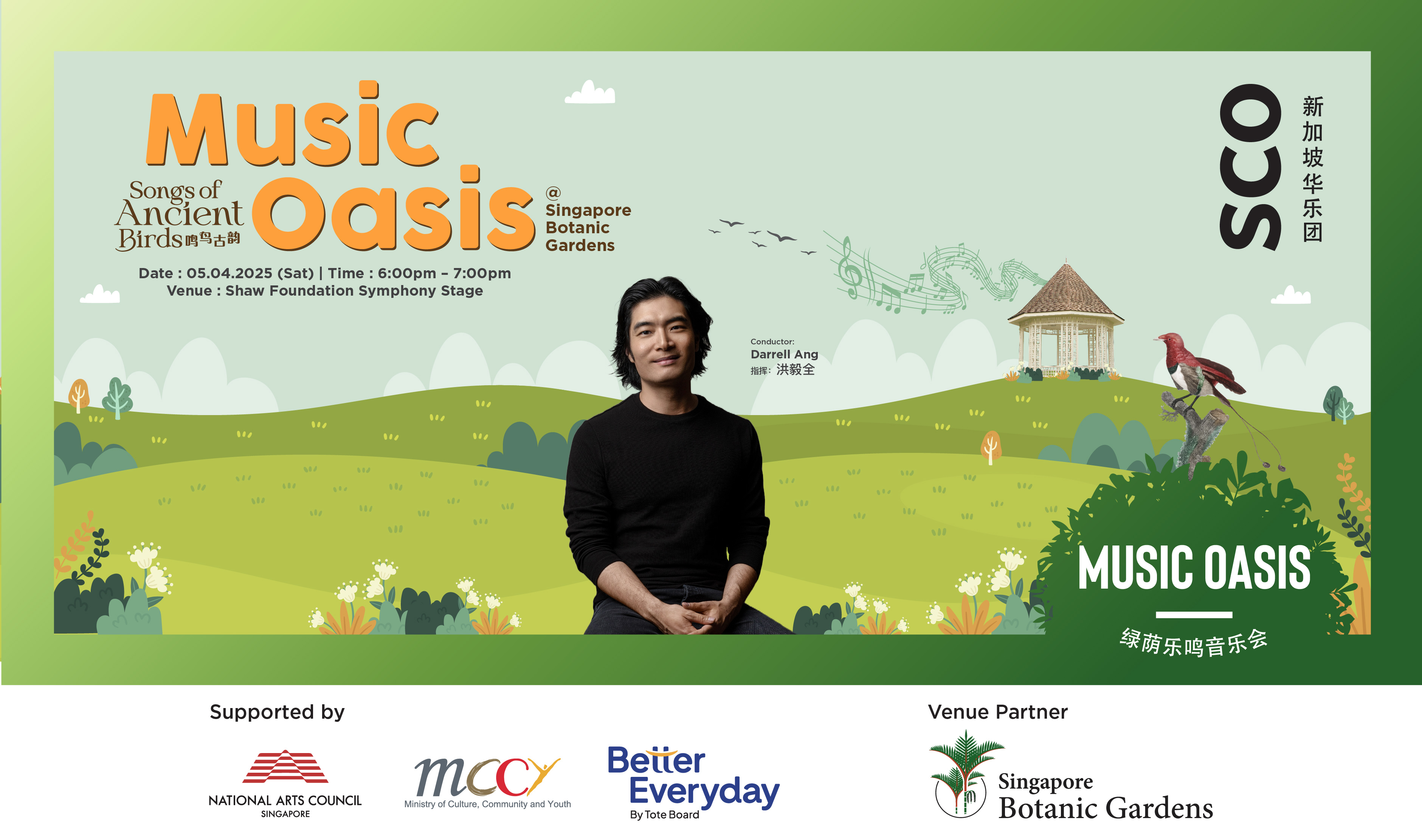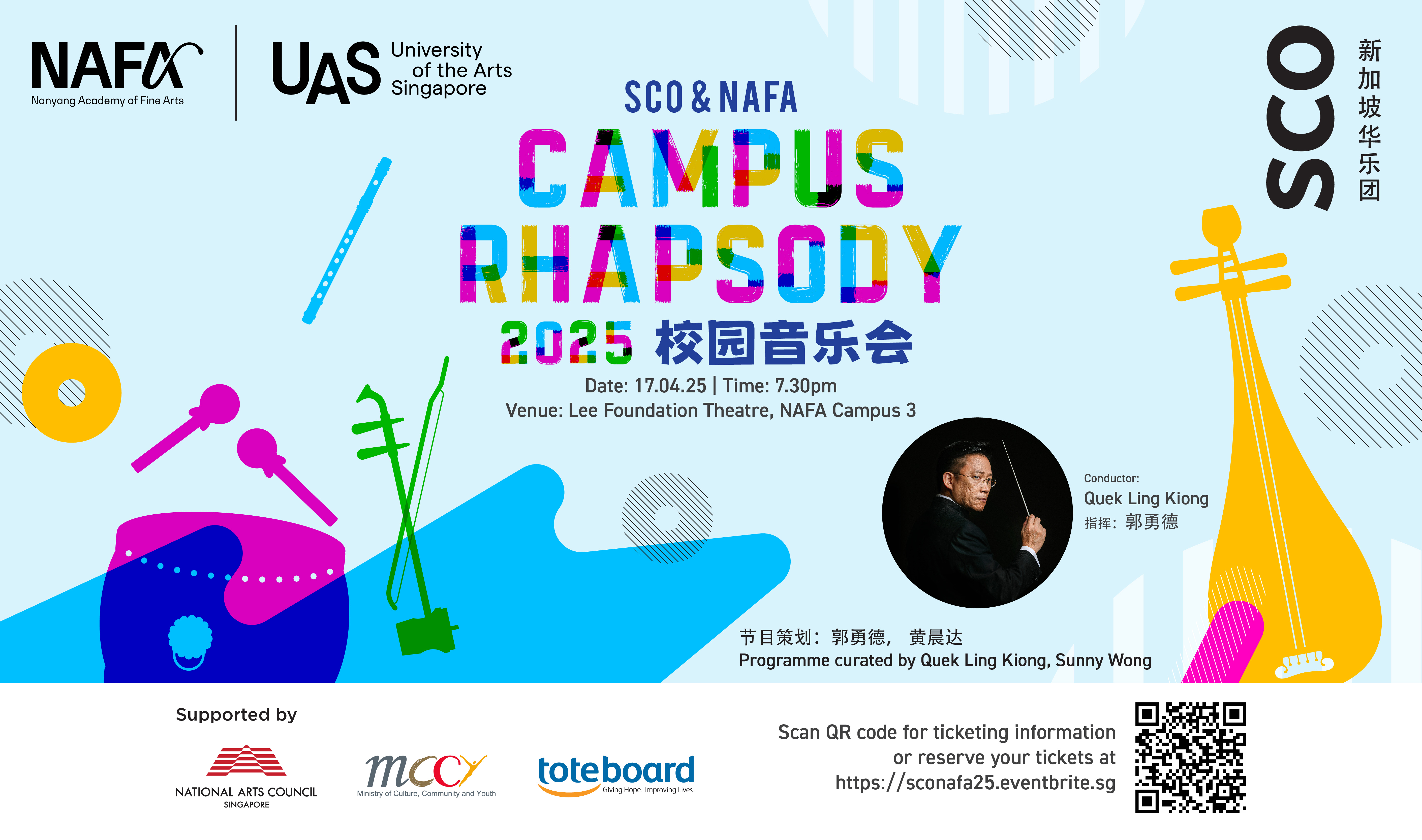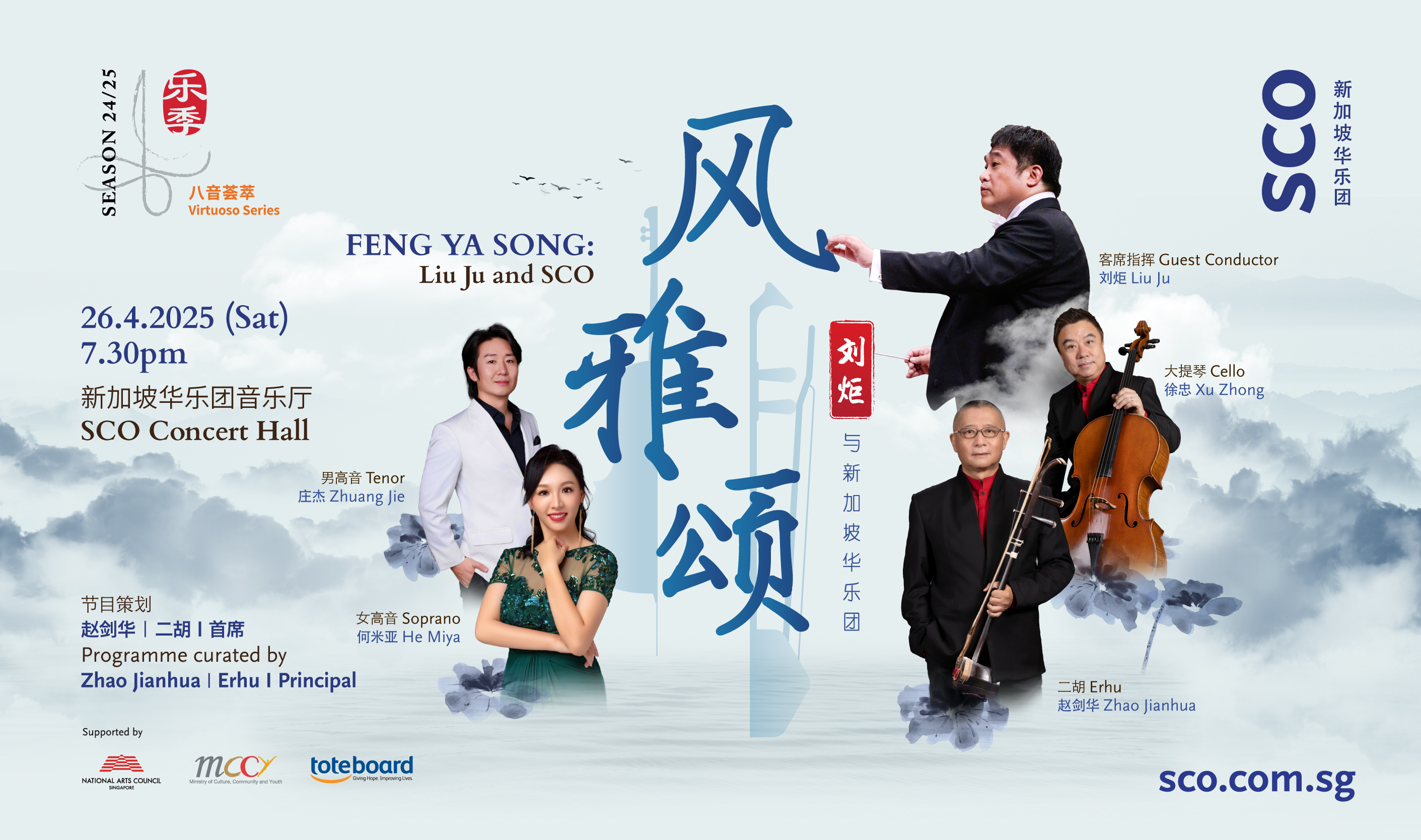Concert Season 24/25 | Virtuoso Series 乐季24/25 | 八音荟萃系列
By Koh Cheng Jin
Curated by SCO Associate Conductor Moses Gay, Towards the Light reflects his personal outlook on light as a source of inspiration for the human spirit. To Moses, light can exist in a multiplicity of forms—as dreams sought-after at the end of the tunnel, as emotional courage when confronted by a new life chapter, and as his own visions for the orchestra’s future. The programme, jointly contributed by soloists Zhu Lin, Lim Sin Yeo and orchestral musician Kenny Chan, ruminates over both the past and future, and conveys the hope for all to voyage through winds and waves in light.
The first piece, Festival Overture, majestically unveils the concert through the brilliant, penetrating declamations of the suona family. This was renowned composer Zhu Jian’er’s first independent symphonic work created in 1958 during his studies in the Soviet Union. It was then rearranged sixty years later by Zha Taiyuan for the Chinese orchestra. The original overture brims with vivid ethnic essence and innovative zest unique to the development of contemporary music in that period. Zhu’s meticulous craftsmanship is largely demonstrated through employing structural aspects of the sonata form, where various main themes undergo complex transformations and displacements. At the same time, this also anticipated boundless prospects of East-West musical integration. An intricate fugue based on the Allegro’s “march-like” theme particularly evinces his flair for polyphonic writing, catapulting listeners into an immersive soundscape. The reappearance and expansion of elegant melodies and characteristic “horse-riding” motifs eventually culminate into an optimistic, emotional high, ushering in the future with resilience and hope.
In contrast to the energetic vitality of Festival Overture, Garden Veils by composer Ho Chee Kong is one that recalls the soft, fuzzy edges of light and nature. It was originally written for the Singapore National Youth Orchestra in 2007 and then adapted for the Chinese orchestra by composer Phang Kok Jun, whose work sensitively captures the original gossamer and transparent sound world. In this version, a seeking, winding melody emerging from the cellos blooms and unfolds gradually over time through a series of intimate dialogues within the orchestra, like a light breeze gently rippling across emerald waters. Amid delicate layers of mist and glow, one is led through a fantastical garden deeply enthralled. The beauty in Garden Veils is one that is suggestive and even numinous, making it distinct from the ensuing works on the program. Its alluring colors were what initially drew Moses to the music and further motivated him as a conductor to further uncover contemporary gems that also encapsulate and luxuriate in the multifaceted sonic landscapes of the Chinese orchestra.
The world’s first known diyin erhu concerto, Fantasia of the Western Regions, commissioned and premiered in 2002 by the SCO, also featured Zhu Lin as the soloist. Similar to Festival Overture, the concerto is a cultural glimpse into the human experience. With its bold exploration of the unique instrument’s features and performance capacity, Zhu highlights the importance of this highly appealing and melodious piece in filling the gap in the diyin erhu repertoire and paving the way for future pieces to come. These contributions, he reminisces, were made possible through mutual collaborative processes undertaken with composer Wang Yueming to uncover the instrument’s limitations and successfully realize the work. Moments in the concerto where high register and swift tempo take precedence are especially challenging for the diyin erhu. One can immediately recognize its naturally succulent and magnetic narrative voice in the passionate introduction and exotically-flavored first section, while alternating vibrant “horse-riding” figurations between the instrument and orchestra later further conjure a seemingly unbreakable and relentless human spirit. A moving melody, invoked pensively by the guan in the third section, is then caressed into longer, yearning utterances by the diyin erhu, before a grand, solemn finale climatically concludes this ardently heroic and patriotic work.
Dizi concerto Cascades, written by renowned dizi performer and composer Yu Xunfa in collaboration with conductor Qu Chunquan in the 70s, is a symbolic work that illustrates the phenomena of drops running into rivers, rivers running into seas. Most meaningfully, soloist Lim Sin Yeo, who greatly benefited from his earlier studies with Yu, also gave the Singaporean premiere of this concerto during the orchestra’s inaugural concert more than twenty years ago. Lim acknowledges that performing this concerto is paying homage to his teacher, the “grandmaster” of the dizi world. Inspired by the magnificent Niagara Falls during Yu's tour with the Shanghai Opera House Dance Troupe in 1977, the work significantly enriches performance techniques, expressive and timbral capabilities of the dizi. For instance, surging waterfalls come alive in the iconic opening through repeated, wide glissandi from the highest to the lowest note of the dizi. This technique, according to Lim, is noteworthy for its idiosyncratic and virtuosic nature at the time of creation. Thriving on contrasts, the concerto encompasses both solemn and graceful melodies, luxurious and light textures, alluring depictions of mountains and rivers, playful imitations of droplets heard in Lushan Fairy Cave, and evocations of bird calls and blooming flowers. These illustrations then coalesce into a zealous, unified song from the orchestra. The eventual return of the introductory “waterfalls” brings full circle the harmonious relationship between human and water, a bond further reinforced by the union of both nature’s grandeur and mystery in this remarkable work.
Similarly inspired by rivers flowing into seas, The Big Tide, composed in 2018 by Wang Yunfei, is the final work of the large-scale suite Qiantang River Melodies. As its finale, the piece dramatically extols the perpetual roar of the “mother river” of China’s Zhejiang Province. What distinguishes it from Cascades is its compact structure as a tone painting, where evolving musical ideas come together in stirring forth an affecting depiction of persistent, ceaseless crashing waves. Amid this powerful imagery transpires a glistening and uplifting string melody subsequently rendered with call and response, gradually forging an impassioned, collective ode to Chinese civilization. In the coda, an animated, primeval percussion cadenza layered with independent entrances finally heralds a climactic, exalted closure to this spectacular impression of the Qiantang River, where its natural landscape and deep heritage basks in full, unreserved glory.
With waves and darkness conquered, the program’s central pursuit eventually materializes in the final work, Towards the Light. As the fifth movement of Liu Changyuan’s Fifth Chinese Symphony “Light” written in 2020 inspired by humanity’s fight against the Covid-19 pandemic, it is a conclusive testament to the inexorable human spirit in rising against, adapting to and overcoming great difficulty. In an interview with Suzhou Chinese Orchestra director Pang Kapang, the original commissioner of the work, Liu reflects on the considerable potential of the Chinese orchestra in exploring all-encompassing themes relating to the human condition and destiny apparent in much large-scale symphonic music. Characteristic in his symphonic writing, Towards the Light is the first movement he penned before the first four. With the foremost aim to invigorate, this finale “recapitulates” and expands iconic themes from the preceding movements, such as the cataclysmic gush of atonal mayhem symbolizing virus and fear in the second movement, The Demon Rages, and the tranquil, introspective theme in the introduction of the first movement, Vibrant Life. However, Towards the Light takes on a more experimental dimension with brief streaks of contemporary techniques, such as aleatoric gestures and dissonant tone-clusters to personify the virus directly. A new, chorale-style dithyrambic ode at the end exalting human triumph over adversity also magnifies the work’s luminous reverberance as both the finale of a magnificent symphony and an exuberant program of rousing, heartwarming music.
文 / 高程锦
“奔向光明” 是由新加坡华乐团副指挥倪恩辉精心策划, 以“寻光”为引的音乐会。关于主题, 倪恩辉感触颇深。他感叹, 在岁月中跋涉的我们都有自己的心之所向, 都在追逐照亮前路的那道光。这道光可能是隧道尽头经努力拼搏而坚守的梦想, 也可能是面对人生新篇章开启的精神力量, 同时也是他畅想新加坡华乐团未来发展的美好愿景。曲目的规划也参考了音乐会独奏家朱霖、林信有与团员曾靖文的建议。在体现回顾过去、展望未来的意识中, 寓意着乘风破浪、沐光而行的希望。
誉为“东方号角”的唢呐, 以高亢洪亮的嗓声奏响《节日序曲》, 隆重地为音乐会拉开帷幕。该曲是著名作曲家朱践耳1958年留苏期间创作的第一部独立管弦乐作品, 六十年后由查太远于2018年移植改编成民族管弦乐版本。在那时候当代音乐发展的重要时期里, 作品既散发浓郁的民族风情, 又蕴含大胆的创新精神。曲子采用奏鸣曲式的结构形式, 通过不同主题跌宕多姿的发展、贯穿、印证作曲家深厚的精巧构思, 也预知中西融合的无限可能。其中以快板“进行曲”为出发点的赋格段落完美显现作曲家精致的复调手法, 活跃生动的多声部对位性结合也反射出立体、饱满的音响色彩, 牵动人心。伴随着优美恬静的曲调与快板“马蹄”节奏的大量运用、扩展, 曲子在充满希望的蔓延和情绪的不断高涨中, 集中体现人民向上、憧憬未来的美好情愫。
相对于《节日序曲》的生气蓬勃,《园中雾幕》则展现光与大自然柔和、朦胧的一面。曲子由作曲家何志光2007年为新加坡青年交响乐团创作 , 而作曲家冯国俊为民族管弦乐移改编的版本则细腻保留了此曲柔软而不失透明的音质。先在大提琴上呈现的主题以半徘徊流连的形态, 逐渐蔓延至乐队的其他声部, 如微风吹皱绿油油的池水泛起阵阵涟漪, 从容不迫。在淡淡光晕与薄雾的交织中, 让人仿佛漫游唯美梦幻的花园美景。《园中雾幕》的美婉转含蓄、空灵玄妙, 与其他曲目形成鲜明对比。倪恩辉回忆, 他当初是被此曲的色彩特点吸引, 而提倡同类展露并发挥民族乐器音色魅力的现代曲目, 与时俱进, 是他身为指挥的的志向之一。
2002年新加坡华乐团委约并首演的第一首低音二胡协奏曲《西域随想》也由朱霖担任独奏。《西域随想》如《春节序曲》, 都是寄托人们情感和精神的文化符号。据朱霖指出, 这首作品旋律性强、雅俗共赏。它的推出填补了低音二胡的一个空白, 从这件乐器的性能、演奏的可行性上, 都做了大胆的尝试, 也为之后的创作和演奏立了一个很好的一个标杆。他回想, 当时为了探索乐器的底线, 作曲家王月明与他进行了充分的沟通, 在逐步的尝试、摸索过程中, 让这作品能够成熟。曲子高音域、快速度的部分都具有挑战性。低音二胡低沉浑厚、富有磁性的叙事音色从激情的引子和洋溢着异国情调的第一段就能感受到。之后, 低音二胡与乐队之间来回交替的轻快“马蹄”音型段落中展现人民坚韧的生命力量。第三段由管子引出的旋律幽深婉转, 低音二胡将其衍化成悠远绵延的长线条, 层层叠进, 仿佛万般思绪涌上心头。结尾磅礴的气势也增添庄严和隆重的气氛, 为这充满深英雄气节、家国情怀的曲子画上亮丽的句点。
笛子协奏曲《汇流》描绘滴水成河、汇流成海的奥妙情景, 是由笛子演奏家、作曲家俞逊发和指挥家瞿春泉共同创作于七十年代的代表性作品。意义非凡的是, 该曲目的本地首演也是由林信有与新加坡华乐团在二十多年前的首演音乐会上呈现, 他也曾向俞逊发学习并提升个人演奏水平。他感慨, 演奏《汇流》主要是他对笛坛一代宗师俞逊发的缅怀感恩和敬意。作品最初灵感来自于俞逊发1977年随上海舞剧乐团演出时观赏的尼加拉瓜大瀑布壮观场面, 曲子借景抒情, 极大丰富了笛子的演奏技法、表现力、音色等方面。开头也是曲子最印象深刻的地方之一, 瀑布从天而降的强大冲击力以笛子从超高音快速历音到最低音的反复中形成。林信有感叹, 这在那年代可说是前所未有、独一无二的高难度技巧。音乐对比十分强烈, 有庄严又优美的旋律, 也有浓厚又轻盈的织体; 有对秀丽山河的唯美抒情, 也有庐山仙人洞里“滴水声”的俏皮模仿; 有鸟儿鸣唱, 也有花儿绽放的生动刻画。一层层的色彩逐渐凝聚成乐队澎湃的齐鸣, 伴随笛子激昂的“瀑布飞泻”重现中, 实现“人水和谐”的循环状态。大自然的雄伟和微妙在作品里兼而有之, 人与大自然环环相扣的紧密联系亦尽显其中。
同样以百川汇流、润泽八方为主题, 作曲家王云飞创作与2018年的《大潮》作为《钱塘江音画》组曲的压轴曲目, 戏剧性营造出浙江母亲河回荡千年的澎湃涛声。与《汇流》不同的是, 整首曲结构更加紧凑, 如交响画卷, 以层叠变化、不断衍变的方式, 一气呵成一首富有感染力的作品, 反映出海浪滔滔不绝的现象。 在一波波振奋人心的力量中, 一段激情、意蕴深远的弦乐旋律浮出水面, 在连绵不断的轮唱推动下, 逐渐形成一首赞美中华文明源远流长的颂歌。接近尾声的打击乐华彩段, 从单一声部逐渐凝聚成咆哮如雷的齐奏, 在强韧动感、原始气氛的带动下, 将曲子带至最后的高潮, 痛快淋漓。曲子庞大的气势集体展示钱塘江壮丽的自然景观、灿烂的文化史、厚重的人文底蕴, 令人回味无穷。
战胜惊涛骇浪、突破黑暗, 音乐会的宗旨在最后一首曲目《奔向光明》体现的淋漓尽致。作为作曲家刘长远2020年以人类抗击新冠疫情为题材创作的第五中国交响曲 《光明》的第五个乐章, 《奔向光明》总结性的传达人们在深渊里披荆斩棘的坚韧不拔。作曲家与委约乐团苏州民族管弦乐团指挥彭家鹏的访谈中说, 民族管弦乐这个形式跟西洋交响乐一样, 也可以展现跨越民俗, 人类、命运等重大题材。《奔向光明》虽然是《光明》的最后乐章, 却也是作曲家习惯性先提笔完成的乐章, 以“鼓舞人心” 的最初动机, 主要“再现”并扩展第二乐章《病毒肆虐》代表病毒和恐懼的无调性喧闹, 与第一乐章《生气勃勃》代表疫情前安逸、美好的内省主旋律。不同的是, 《奔向光明》中间加了较为抽象的片段与其他现代音乐技巧, 比如不协调音簇等, 直接描写病毒本身的扩散和蔓延。乐章也在最后孕育出新的众赞歌主题, 一齐咏唱人们百折不挠、逆流而上的精神, 达到超凡脱俗、余味隽永的效果。



